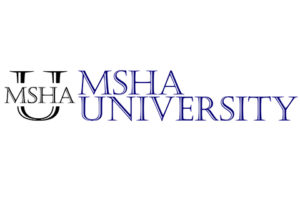The Mine Safety and Health Administration (MSHA) defines training requirements for both surface and underground mining in Parts 46 and 48 of Title 30 of the Code of Federal Regulations (CFR). You may already know that Part 46 is for surface, non-metal, non-coal mining and Part 48 is for underground mining and surface areas of underground mines. And while that’s a great place to start, there’s a lot more to know about the differences between MSHA Part 46 and Part 48 federal standards.
So, what are the 3 major differences between MSHA Part 46 and Part 48? The 3 major differences between Part 46 and Part 48, include:
- The types of mining each regulation covers,
- The training requirements for miners and mining contractors, and
- The specific ways that MSHA oversees and enforces these two sets of regulations.
If you’re suddenly faced with the requirement to get your team MSHA training and you don’t know where to start, don’t panic. You’re in the same boat as many thousands of others who’ve had to quickly learn all the ins and outs of MSHA’s regulations. And federal regulations aren’t typically written to be easy to understand. So, it can all be very confusing. But we’ve got you covered. This article will go over everything you need to know about Part 46 and Part 48 so you can be sure which regulations you’ll have to comply with and what training you’ll need. There’s a world of difference between these two sets of regulations. So, let’s get started.
1 – Types of Mining That Part 46 and Part 48 Cover
The fundamental difference between Part 46 and Part 48 has to do with the type of mining that each is intended to regulate. At the most basic level, Part 46 regulations are for surface mining and Part 48 is for underground mining. But it’s not that simple. To be as accurate as possible, the two standards reside on either side of a line based on:
1) the type of commodity being mined (metal or non-metal), and
2) the location of the mining operations (surface or underground).
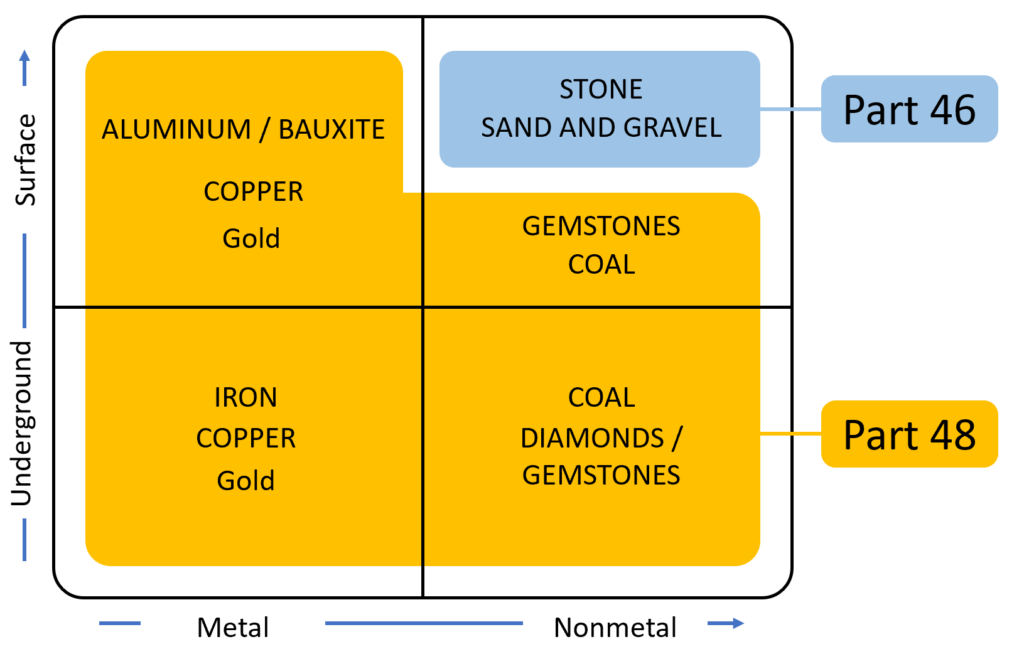
It’s also important to understand that Part 48 is split into two sections:
- Part 48A – Regulations for training UNDERGROUND miners
- Part 48B – Regulations for training miners at SURFACE AREAS of UNDERGROUND mining operations
So, based on the commodity and the mining location, here are the types of mining covered by either Part 46 or Part 48(A and B).
Part 46
- Surface operations only
- Non-metal
- Non-coal
- Non-gemstones
Part 48 (A and B)
- Underground operations (Part 48A)
- Surface areas of underground mining operations (Part 48B)
- Metal
- Coal
- Gemstones
Here are some examples of both Part 46 and Part 48 mines:
- A mine with surface operations only that produces Oregon sunstone, a semi-precious gemstone.
- That’s a Part 48 mine because the commodity is a gemstone, even though it’s only at the surface.
- A surface sand and gravel mine.
- That’s a Part 46 mine because it’s surface, non-metal, non-coal, and non-gemstone.
- A coal mine with surface operations only.
- That’s a Part 48 mine because it’s a coal mine.
- A shell dredging operation at the mouth of a Gulf Coast bay.
- That’s a Part 46 mine because it’s surface, non-metal, non-coal, and non-gemstone.
- An underground diamond mine.
- That’s a Part 48 mine because it’s underground and focused on gemstones.
While it may not always be 100% clear in the regulations, MSHA does draw hard lines between the types of commodities and the mining operation locations to help ensure that everyone knows which part they’ll be required to comply with.
Keep in mind that Part 48 defines two separate training requirements based on whether the miner performs work underground (Part 48A) or at surface areas of the underground mine (Part 48B).
And it’s critically important to understand which regulations apply to you, because the training requirements and enforcement policies for Part 48 (A and B) are very different from Part 46.
2 – Training Requirements for Part 46 vs Part 48 Miners and Mining Contractors
While there is some overlap in training subjects, there are several extremely important differences between Part 46 and Part 48 training requirements. These differences fall into three main categories:
- Time – Training time requirements (minimum amounts of time and deadlines)
- Subjects – Training subjects required
- Methods – Training methods allowed by MSHA
Here’s what the Part 46 (Surface) and Part 48 (A-Underground and B-Surface Areas) training requirements for New Miners look like when aligned with overlapping (highlighted in green) and requirements/subjects unique to that standard (highlighted in yellow).
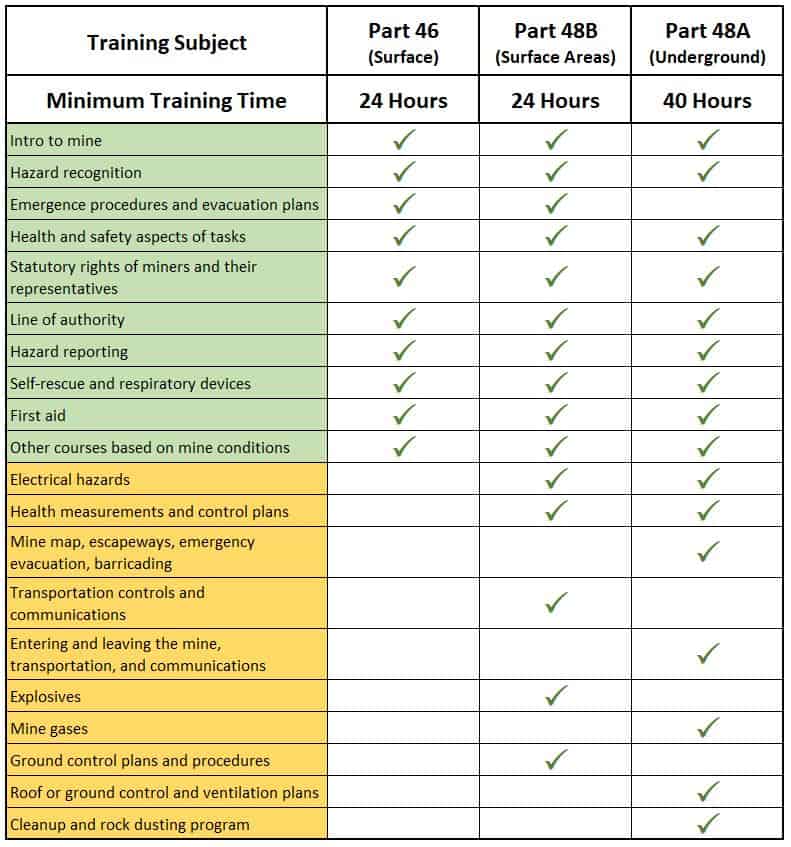
Training Time Requirements
Some important differences between Parts 46 and 48 have to do with requirements related to the:
- Minimum Training Times – minimum amounts of training time required, and
- Training Deadlines – timing of when training must be completed.
The minimum training time requirements for New Miner training can be broken down like this:
- Part 46 require a minimum of 24 hours of training.
- Part 48B also requires a minimum of 24 hours of training.
- Part 48A requires a minimum of 40 hours of training.
And since MSHA places timing deadlines on training in each case, here’s how that breaks down:
- Part 46 requires 7 specified subjects be completed with a minimum of 4 hours of training (of the total 24) prior to a miner beginning work at a mine.
- Part 46B requires 3 specified subjects be completed with a minimum of 8 hours of training (of the total 24) prior to a miner beginning work at a mine.
- Part 48A requires that all 40 hours of training be completed prior to a miner beginning work at a mine.
Part 46 also provides two additional deadlines for completion of the 24 hours of training:
- Within 60 days of a miner beginning work at a mine, training on first aid and respiratory devices must be completed.
- Within 90 days of a miner beginning work at a mine, any remainder (if any) of the 24 hours of require training must be completed.
And Part 48B also offers an additional deadline:
- Within 60 days of a miner beginning work at a mine, all of the remaining 16 hours of training must be completed.
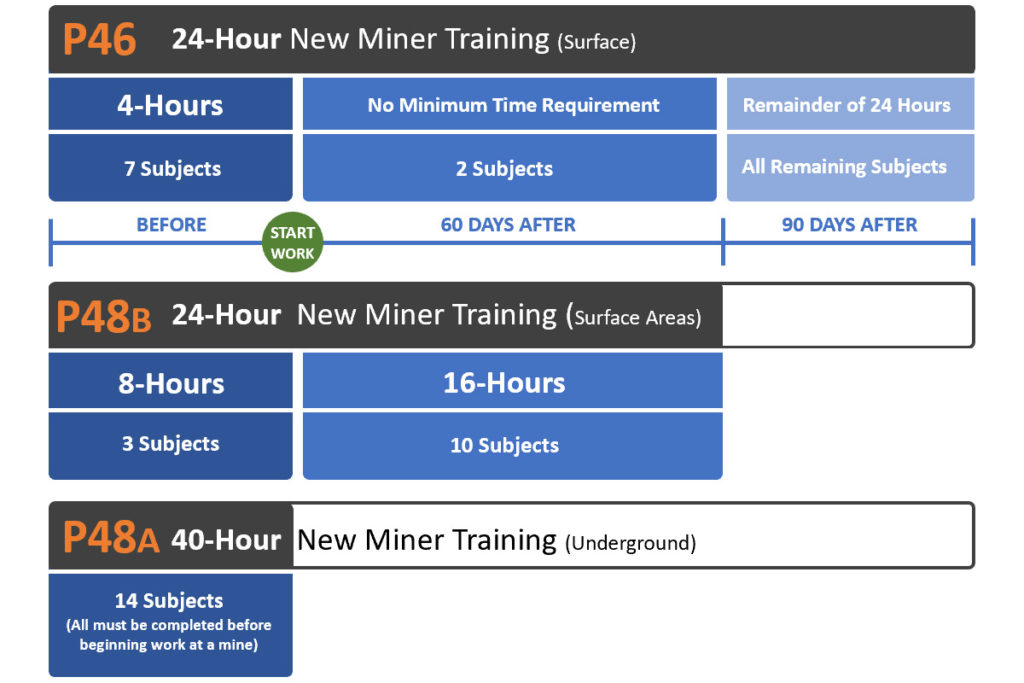
Training Subjects
While there’s significant overlap in required training between Parts 46 and 48, the main differences relate to training subjects specified in Parts 48 A and B that aren’t required for Part 46 training. These subjects include:
- Electrical hazards (Part 48A+B)
- Health measurements and control plans (Part 48A+B)
- Mine map, escapeways, emergency evacuation, barricading (Part 48A)
- Transportation controls and communications (Part 48B)
- Entering and leaving the mine, transportation, and communications (Part 48A)
- Explosives (Part 48B)
- Mine gases (Part 48A)
- Ground control plans and procedures (Part 48B)
- Roof or ground control and ventilation plans (Part 48A)
- Cleanup and rock dusting program (Part 48A)
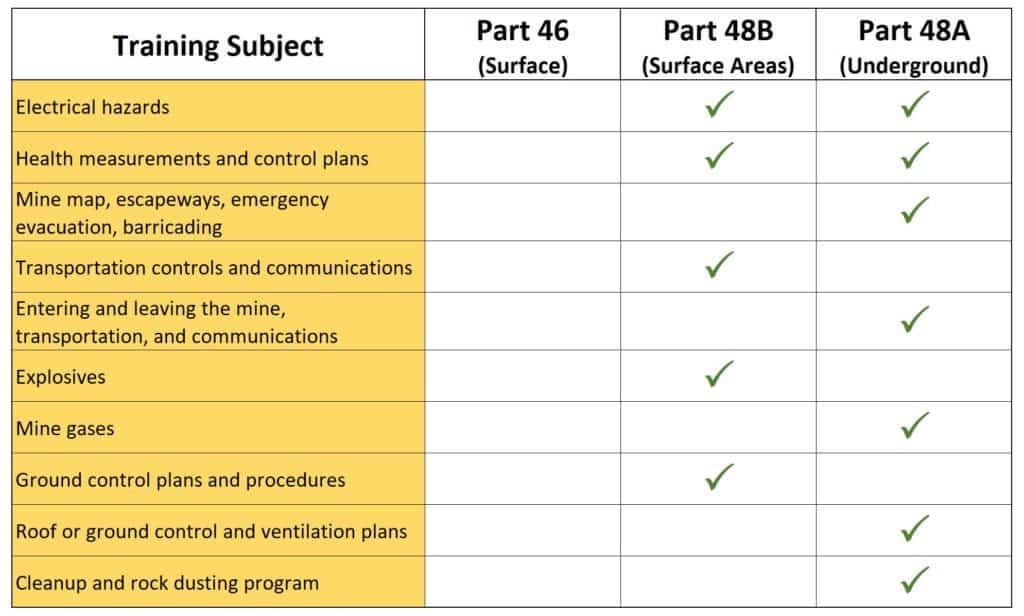
Training Methods
Other critical differences between Part 46 and Part 48 include:
- Where training can take place,
- How training can be delivered, and
- Who can deliver it.
Where Training Can Take Place
While Part 46 and Part 48B don’t specify where training must take place, Part 48A does. Among the 40 hours of training required for Part 48A new miners, MSHA specifies that approximately 8 of the 40 hours must be done at the mine site.
How Training Can Be Delivered
Part 48A also specifies that “training shall be conducted in conditions which as closely as practicable duplicate actual underground conditions.”
While both Parts 46 and 48 may be delivered online, MSHA has some very strict rules in place for Part 48 online training providers.
- Part 48 online training must be approved by MSHA.
- Part 48 online training must be either delivered live by an MSHA approved trainer or provide access to an MSHA approved trainer to answer questions in real-time.
Who Can Deliver Training
MSHA places different requirements on who may deliver training for Part 46 compared to Part 48. The main difference is related to the competent person versus the MSHA approved trainer.
Part 46 requires that training be delivered by a competent person. A competent person means “a person designated by the production-operator or independent contractor who has the ability, training, knowledge, or experience to provide training to miners in his or her area of expertise. The competent person must be able both to effectively communicate the training subject to miners and to evaluate whether the training given to miners is effective.”
Part 48 requires that training be provided by an MSHA approved instructor. Instructors are approved by MSHA in one of the following ways:
- Pass an instructor’s training course conducted by the MSHA District Manager.
- Instructors can be designated by MSHA as approved based on written evidence of the person’s qualifications.
- Instructors can be designated by MSHA as approved based on the instructor’s performance while teaching a class monitored by MSHA.
The competent person or MSHA approved instructor can be either a mine employee or a non-employee trainer contracted by the mine to conduct the training.
3 – MSHA Enforcement of Part 46 vs Part 48
Overall, MSHA places more regulatory requirements and rigid enforcement on Part 48 than on Part 46. This isn’t to say that MSHA is lenient on Part 46 mines. MSHA simply provides more flexible training requirements to Part 46 operations.
For example, MSHA requires Part 48 mines to submit training plans for approval, while a Part 46 training plan is “considered approved” if it contains a specified set of information.
MSHA also allows Part 46 miners to be trained by a person deemed competent in the subjects by the mine operator. This designation of a competent person does not exist in Part 48. All Part 48 training must be conducted by an MSHA approved instructor.
And when it comes to inspections, when MSHA reviews a mine’s training documentation, the required number frequency differs for Part 46 and Part 48. Part 46 mines must be inspected twice a year, while Part 48 mines must be inspected four times per year to ensure compliance with health and safety standards.
Related Questions
Does MSHA accept online training for Part 48?
Yes, but only from online training providers who have MSHA approval. And online training providers must either deliver the training with a live MSHA approved instructor or have an MSHA approved instructor available during training for questions.
Be sure to confirm with any online training provider that they have been approved by MSHA to provide Part 48 training.
Part 46 training, on the other hand, is not required to be delivered by an MSHA approved instructor. So, there is no MSHA approval required for a company to deliver Part 46 training online. But a competent person must still be available for questions during training. Coordinating that will be up to your mine operator to ensure you’re compliant with that Part 46 requirement.
How do I fill out a 5000-23 Certificate of Training?
Check out our article on the 5000-23 – “How To Fill Out An MSHA 5000-23 Certificate of Training”
